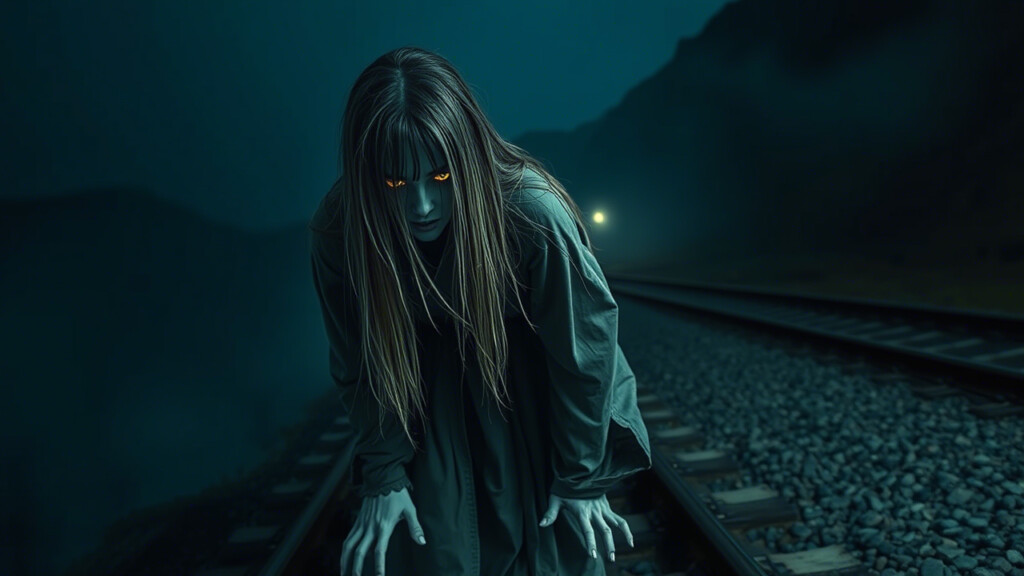(Warning: If you’re near a train track, it’s best not to continue reading. Or at least, make sure nothing is crawling at your feet…)

1. Is This Legend Real or Just a Cruel Prank?
Japan is no stranger to spine-chilling ghost stories, but Teke Teke remains one of the most infamous urban legends that keeps Asian netizens awake at night. A ghost that drags itself forward using its hands, pulling its torn upper body while making an eerie “tek… tek…” sound. She doesn’t just wander to scare people—she hunts them. And if she catches you, your fate will mirror hers: you’ll be torn in half.
But hold on—if Teke Teke is truly terrifying, why hasn’t anyone caught her hunting on camera? If she’s faster than a track athlete, why isn’t there any CCTV footage? Or is this legend just an elaborate scare tactic?
Let’s dissect this ghost—both literally and figuratively.
2. Kashima Reiko – The Haunting Spirit
The most popular version of the legend claims that Teke Teke was once a high school girl named Kashima Reiko.
On a freezing night, Reiko crossed a railway track. Some say she tripped, others whisper that she was pushed. A darker version claims she was assaulted and left to die. Whatever the truth, the result was the same: a blinding light, a deafening roar, and then—silence. When the train had passed, the tracks were painted red. Her lower half was nowhere to be found.
But the story doesn’t end there. They say Reiko’s soul couldn’t rest. With nothing but her arms to drag her forward, she crawled through cities, her broken fingernails scraping against the pavement, searching for her missing legs. Anyone who locked eyes with her met the same gruesome fate—torn in two.
But wait—why does Japan have so many ghost stories about vengeful women?
Kashima Reiko, Hanako-san, Kuchisake-onna, Oiwa—their origins are different, but their anger is the same. Women who suffered injustice, who died in agony, who returned not for peace, but for revenge.
In a society where quiet endurance is expected, where suffering is often hidden, these spirits embody a raw, unfiltered rage. Perhaps that’s what makes them so terrifying. They don’t ask for justice. They take it.
3. Teke Teke – A Warning from Adults?
Imagine being a Japanese parent. You want your child to stay away from railway tracks. Instead of saying, “Don’t go there, it’s dangerous,” you tell them this story:
💀 “If you go near the tracks at night, a ghost will crawl after you and cut your body in half. If you answer her question wrong, you will die.”
A spine-chilling warning, but an effective one.
If Teke Teke is merely a cautionary tale to scare children, does that mean she never existed?
Or did she exist once—but her story was twisted over time?
4. Strange Encounters – Evidence or Mass Hysteria?
While this legend sounds like a typical horror story, there have been strange reports of people who have actually seen Teke Teke.
📌 Tokyo, 2025 – A CCTV video has gone viral on Twitter (now X), showing a “dark figure crawling on the road” at 2 AM. However, the footage is of extremely low quality—perhaps because the ghost deliberately interfered with the signal to prevent a clear analysis. Many claim that the figure moves at an unnaturally fast speed, while others haven’t ruled out the possibility that the ghost filmed the video itself and uploaded it online—perhaps from the account @TekeTeke.
Do you believe it? Well, only ghosts would believe that a ghost posted the video.
This story could just be a psychological effect or a collective hallucination – but if one night you hear the sound of ‘tek… tek…’ behind you, would you dare to turn around?
5. Can Science Explain Teke Teke?
If we strip away the supernatural, we can consider several logical explanations:
🧠 1. Psychological Effects & False Memory
When we hear about a legend, our brain automatically creates images and sensations related to it. This can lead to hallucinations—you might think you hear “tek… tek…” when it’s just footsteps or the wind.
🦵 2. Ghost Limb Syndrome
People who lose limbs often still feel them. If the living can experience this, can ghosts feel it too? Perhaps the Teke Teke legend represents a deeper fear of losing one’s body, identity, or autonomy.
🚆 3. A Real-Life Accident?
There are rumors that this legend was inspired by a real train accident in Hokkaido in the 1960s. However, no official records confirm such an incident—perhaps because ghosts don’t like doing paperwork.
Teke Teke may just be a terrifying bedtime story, but it reflects Japan’s cultural fears—of restless spirits, urban accidents, and unresolved trauma.
Believe it or not, one thing is certain: this legend continues to keep millions awake at night.
Would you dare re-read this at 3 AM? 💀
